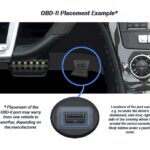Experiencing issues with your 2003 Chevy Suburban’s OBD2 port? If you’ve tried to plug in a scanner to check that pesky “Service Engine Soon” light and found there’s no power, you’re likely facing a common problem: a blown fuse. Before you delve into complex electrical diagnostics, the simplest and most frequent culprit is often a fuse. Let’s explore how to identify and address the OBD2 fuse issue in your 2003 Suburban.
The On-Board Diagnostics II (OBD2) port is crucial for modern vehicle maintenance and diagnostics. It’s the gateway for mechanics and DIYers to communicate with your Suburban’s computer system, read trouble codes, and understand what’s going on under the hood. When this port suddenly loses power, it becomes impossible to use diagnostic tools, leaving you in the dark about potential engine or system problems.
Fortunately, a non-functional OBD2 port is frequently due to a blown fuse. Fuses are designed to protect electrical circuits from overloads, and if there’s a surge or short in the OBD2 system, the fuse will blow to prevent damage to more expensive components.
So, which fuse should you be looking for on your 2003 Chevrolet Suburban? The fuse that powers the OBD2 port is typically located in the underhood electrical center (fuse box). While it’s always best to consult your Suburban’s owner’s manual for the definitive fuse location and designation, on many 2003 Suburban models, you’ll find a fuse dedicated to the Data Link Connector (DLC), which is another name for the OBD2 port. This fuse is often a 15 amp fuse and might be labeled as “OBD II,” “DLC,” or something similar. A common location is position #19 in the underhood fuse box, but always verify with your vehicle’s specific fuse diagram.
Here’s a simple step-by-step guide to check and replace your 2003 Suburban’s OBD2 fuse:
- Locate the Underhood Fuse Box: This is usually under the hood on either the driver’s or passenger’s side of the engine compartment.
- Find the Fuse Box Diagram: The fuse box cover should have a diagram on the underside indicating what each fuse protects. If not, check your owner’s manual.
- Identify the OBD2/DLC Fuse: Look for a fuse labeled “OBD II,” “DLC,” or similar. Again, fuse position #19 (15 amp) is a likely candidate on a 2003 Suburban.
- Inspect the Fuse: Carefully remove the fuse using a fuse puller (often found in the fuse box). Hold it up to the light and check if the thin wire inside is broken or melted. A blown fuse will have a visible break.
- Replace the Fuse: If the fuse is blown, replace it with a new fuse of the exact same type and amperage (e.g., 15 amp). Do not use a fuse with a higher amperage rating, as this could damage the electrical system.
- Test the OBD2 Port: After replacing the fuse, try using your OBD2 scanner again to see if it now powers up and can communicate with your vehicle.
If replacing the fuse resolves the issue, you’re back in business! However, if the fuse blows again immediately or the OBD2 port still has no power, there might be a more serious underlying electrical problem, such as a short circuit in the wiring or a fault within the OBD2 connector itself. In such cases, it’s advisable to seek professional diagnosis from a qualified mechanic to prevent further electrical damage and ensure accurate repairs. While a blown fuse is often a simple fix, persistent OBD2 port issues warrant expert attention to pinpoint and resolve the root cause effectively.
